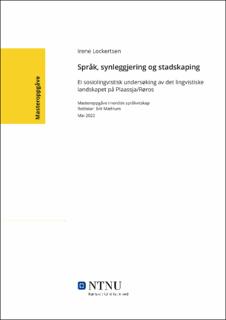| dc.description.abstract | I 2018 blei Røros kommune innlemma i forvaltningsområdet for samisk språk, som den hittil sørlegaste kommunen, og ein av fire sørsamiske kommunar. Som medlem i forvaltnings-området er kommunen pliktig å skilte tospråkleg på vegskilt og kommunale bygg. Dette representerer ei endring der sørsamisk språk blir meir synleg enn det tidlegare har vore på staden.
I denne masteroppgåva undersøker eg det lingvistiske landskapet på Plaassja/Røros. Lingvistiske landsskapsstudiar har synleg skriftspråk i offentlege rom som studieobjekt. Eg er interessert i å undersøke kva for språk og stadkjensle ein blir presentert for gjennom det lingvistiske landskapet i kommunesenteret. Dessutan ønsker eg å sjå nærare på korleis maktstrukturar kan vere med å påverke kor synlege dei ulike språka er. Eg tar utgangspunkt i at lingvistiske landskap både reflekterer og influerer haldningar til språk og språkbrukarar, og at dei slik sett kan fortelje mykje om det aktuelle språksamfunnet.
Datagrunnlaget for oppgåva er fotografi av det lingvistiske landskapet i Røros sentrum, samt ei mindre undersøking av bygda Brekken og digitale lingvistiske landskap. Ein annan datakjelde er intervju med personar frå Røros kommune om tema som identitet, tilhøyrsel og etnisitet.
Analysen er delt inn i tre kapittel, som belyser tre innfallsvinklar for å forstå det lingvistiske landskapet på Røros - nemleg stad, språk og makt. Undervegs i desse kapitla presenterer eg funna mine, og inkluderer nokre teoretiske perspektiv for å forstå det lingvistiske landskapet.
I oppgåva viser eg at det sørsamiske språket på Røros er marginalt til stades i det lingvistiske landskapet, medan norsk og Røros-dialekt har ein hegemonisk posisjon. Eg argumenterer for at denne asymmetrien kan forklarast med bakgrunn i tankar om ønska sjølvrepresentasjon, og ikkje minst med fortidas fornorskingsprosessar. Eg peiker på korleis fortida som bergstad har ein sentral posisjon i Røros si sjølvforteljing, og at dette medfører at andre forteljingar om Røros hamnar i skuggen. Med utgangspunkt i at ein stad er ein sosial konstruksjon, trekker eg fram at det lingvistiske landskapet er ein arena for reforhandlingar om kva for ein stad Røros er, og kven som høyrer til der. Medlemskapet i språkforvaltningsområdet er eit tydeleg steg i ein slik forhandlingsprosess, og dermed eit insitament til avkolonisering. | |
| dc.description.abstract | In 2018, Røros municipality in Norway was included in the Administrative Area of Sámi Language, as the hitherto southernmost municipality, and one of four Southern Sámi municipalities. As a member of this administrative area, the municipality is required to install bilingual signs on roads and buildings, thereby increasing the visibility of Southern Sámi within the municipality.
This thesis explores the linguistic landscape (the written language in public spaces) of Plaassja/Røros, and which languages and what sense of place are presented through the linguistic landscape of the municipality center. Moreover, this thesis examines how power hierarchies influence the visibility of different languages within the Røros municipality. As a point of departure, I assume that linguistic landscapes both reflect and influence attitudes toward languages and language users, and thus provides insights on the language society in question.
The data source for the thesis are photographs of the physical linguistic landscape in Røros, as well as a minor study of the village Praahka/Brekken and digital linguistic landscapes. In addition, citizens of Røros municipality were interviewed on subjects like identity, belonging, and ethnicity.
The analysis is structured into three chapters, that consider the linguistic landscape from different angles – namely language, place, and power. These chapters present findings from the survey of the linguistic landscape, and include theoretical perspectives to interpret to better comprehend these findings.
The thesis shows that the Southern Sámi language in Røros is only marginally represented in the linguistic landscape, whilst Norwegian and the Røros dialect have a hegemonic position. This asymmetry may be explained by thoughts of self-representation, as well as the cultural assimilation processes of the past. Crucially, Røros’ history as a mining town is central to Røros’ self-identity, and this entails an overshadowing of other cultural and historical aspects. Understanding place as a social construct, this thesis underscores the linguistic landscape as an arena for negotiation of Røros as a place, and to whom it belongs. The membership in the administrative language area is a clear action in such a negotiation process, and consequently an incentive to decolonialization. | |
